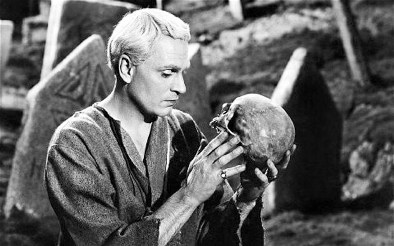 Laurence Olivier’s 1948 version of Shakespeare’s great tragedy won Oscars for Best Picture and Best Actor.
Laurence Olivier’s 1948 version of Shakespeare’s great tragedy won Oscars for Best Picture and Best Actor.
Laurence Olivier was one of the 20th century’s greatest Shakespearean actors. He also directed eight films in his career—the first three were versions of Shakespeare, and those are the ones that really made his reputation as a filmmaker. Henry the Fifth came out near the end of 1944, when Britain could feel assured of victory in the Second World War. It’s a gorgeous, rousing Technicolor marvel that of course emphasizes English courage and character in the context of a war.
Hamlet was released in 1948. Like its time, Olivier’s Hamlet is mysterious, provocative, and dark. There are many things to criticize about it, and a lot of people did and still do, perhaps partly because it had won Best Picture and Best Actor at the Oscars.
The film’s production design by Roger Furse, with its eerie stone castle of endless steps; haunted, dreamlike, suspended in clouds—is a marvel. This is a stark vision, conveyed unforgettably by Desmond Dickensen’s deep focused black & white photography. The music by William Walton is perfect. Elsinore is a spooky ethereal place with cramped rooms through which the camera moves restlessly. When the Ghost appears, we hear a deep heartbeat accompanying his distorted voice. There’s a nightmare quality to this Hamlet.
Shakespeare’s great tragedy is a work of marvelous excess which can’t help but leave an imprint on you, if you’re open to it. Hamlet himself is so bold a character, a man whose contradictions make him more rather than less believable, that there’s a temptation to go around talking like him after you’ve read the play. No wonder he’s considered the actor’s great challenge.
The problem in a film of Hamlet is always where to cut. It’s Shakespeare’s longest play, and unless you want a four-hour film (or a three-and-a-half hour film where everyone speaks the lines too fast) you must cut something. Olivier’s solution was to cut Rosencrantz and Guildenstern, the false friends hired by Claudius to find out what Hamlet’s up to. I respect that decision, even though I miss the delightful wordplay in their scenes. It changes some of the meanings, but it does help the picture fit into a two-and-a-half hour running time.
Olivier has the famous “to be or not to be” soliloquy done in thought rather than speech—we see Hamlet lying on the battlements, staring silently at the sky, while Olivier performs the soliloquy in voice-over. One must admire the willingness to try such things.
I love the way the camera pulls away into a long shot and then back into close-up as Claudius and Laertes plot their treachery. (Basil Sidney’s Claudius is so good that he is my image of him.) The death of Ophelia (played beautifully by 18-year-old Jean Simmons) is visualized, and this gives the Queen’s account an added poignance. The scene where the play catches the king’s conscience is quite striking (although we only get the dumb show). The look and feel of the picture is like no other—it’s hard to shake the imagery from your mind. If you’re not familiar with the play it may inspire you to become so.
Hamlet, directed by Laurence Olivier, is not the definitive version on film. I don’t think one exists yet. But it’s one that any lover of filmed Shakespeare must see.

A group of young people plan to blow up an oil pipeline in Texas, in this climate activism thriller. How to Blow Up a...

One of my favorite movies from recent years was A Separation, an Iranian film about the breaking apart of a family that ended up...

A classic film about lovers who are jewel thieves represents the height of style from director Ernst Lubitsch. A fortunate director can point to...